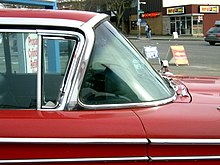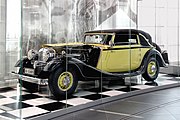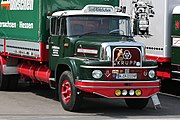Panorama window


The term panorama window is historically used for a specially shaped and cut windshield or rear window in an automobile. The pane surface is curved on the sides by up to 90 ° to the longitudinal axis of the vehicle. The disc is also cut so that the lower rounded corners each have an acute internal angle. The A-pillar is therefore inclined in the opposite direction at pane height, in contrast to the usual construction. The door side windows compensate for this difference in dimensions with a front vent window that is shorter at the bottom than at the top. There are also models with a 90 ° angle for the A-pillar. In the case of a panoramic window in the rear window, the side body frame also runs in the opposite diagonal direction compared to conventional designs.
- early constructions to improve visibility
Willys-Knight chauffeur limousine with a multi-part window construction that was intended to both improve visibility and divert raindrops (advert from 1920)
Horch 670 with a three-part windshield
Bugatti Type 57 Labourdette Coach Profilée with "Vutotal" windshield (1936)
Panhard & Levassor X72 Panoramique with small panes in the A-pillars
Today, other generously designed car windows protruding into the roof area are known as "panorama windows" or "panorama windshields". Occasionally, windshields that are pulled far forward are also referred to as such.
Early versions of a panoramic view
Efforts have been made to improve all-round visibility in cars since the 1920s. Closed bodies often received complicated stems with multi-part windows, but the support of the primitive windshield wipers was more likely to have been in the foreground. Edmund Rumpler was the first to use curved glass for car windows. His Rumpler teardrop car had a vertical windshield that curved into the curved side windows. This resulted in low drag with good visibility.
Carrosserie Georges Gangloff in Switzerland, with an innovative door hinge, and Jean-Henri Labourdette in France, with a frameless windshield, pursued a different creative approach . Gangloff's door system came to the USA through the designer Frank Spring (1893–1959) and for several years was an improved version called Clear Vision , patented by the Walter M. Murphy Company in Pasadena (California) .
With Labourdette's patented “Vutotal” (derived from Vue totale , “total view”), A-pillars should be dispensed with entirely. One component was extra-thick glass that was partially supported by the construction. However, interventions in the construction of the roof or convertible top were necessary, and the system was very expensive.
In the next phase, an attempt was made to move the A-pillar back to the side in order to improve the field of vision towards the front. From the mid-1930s, this led to two-part windshields on numerous vehicles. The two halves were attached at a slight angle to each other, which also resulted in a little less air resistance.
The Tatra 77 from 1934 and various models from Panhard & Levassor (including X72 Panoramique, Dynamic from 1936) had three-part windows. The sloping middle section was framed by two small panes on the A-pillars, which were flat in the Tatra and rounded in Panhard & Levassor.
Panorama window as design fashion
The first vehicle with a panoramic window was the “Le Saber” concept study presented by General Motors in 1951 . The design study comes from Harley Earl , then Head of Development at General Motors. The vehicle contains elements of the Googie style that is contemporary in architecture , such as B. tail fins and a grille that adopts style features of a jet fighter. The panoramic window was another design feature. The American designation is "wrap-around windshield". In 1952 (for the 1953 model year), the Cadillac Eldorado was probably the first production vehicle with a panoramic window. In the years that followed, the panorama window became a design feature of almost all US passenger cars, especially road cruisers , as well as pick-ups . In the second half of the 1950s, fashion also came to Europe. It was well received by the German automobile manufacturer Opel and the British manufacturer Vauxhall as well as other manufacturers. Even small cars have been equipped with panoramic windows. The idea of Labourdette was followed up by Pininfarina . In 1956, the designer presented the Ferrari Superfast, a study based on the Ferrari 410 Superamerica , which was constructed entirely without an A-pillar. However, the vehicle had to be redesigned after problems with rigidity.
Panorama panes disappeared again in the early 1960s .
Use
The practical use of panorama windows is assessed differently. In particular, compared to the previously common small, smooth-surfaced or slightly curved windshield, it significantly improved the field of vision towards the front. This increase in safety was made possible by further developed processes in glass production and processing in automobile construction. The advertising spoke of an improved side view that increased security. However, it did not live up to the promise of a panoramic view, as there was still a window pillar. There were also practical disadvantages: getting in at the front was sometimes hindered by the window corner protruding to the rear, and the interior could get very hot due to the large glass surfaces. In the event of a crash, the A-pillar could not transmit the same amount of forces to the roof area due to its kinked shape.
Historical examples of the panoramic window
The following vehicles, among others, were equipped with panoramic windows:
- Panorama pane examples
Buick Roadmaster 1958
Opel Rekord P1 1957-1960
Borgward P 100 1960/1961
Lloyd Arabella 1959-1963
GMC 150 blue chip 1956
Krupp truck with panoramic windscreen 1959–1968
American models
- Cadillac Eldorado
- Cadillac DeVille
- Cadillac Sixty Special
- Chevrolet Task Force (pick-up)
- Chevrolet Corvette C1
- Chevrolet Bel Air
- Chevrolet Impala
- Imperial
- Buick Electra
- Buick LeSabre
- Buick Limited
- Buick Roadmaster
- Edsel
- Ford Fairlane
- Ford F-Series (pick-up)
- Ford Thunderbird
- Oldsmobile 88
- Oldsmobile 98
- Packard 400
- Packard Caribbean
- Packard Clipper
- Packard Executive
- Packard Patrician
- Pontiac Star Chief
- Rambler Ambassador
German models
- Auto Union 1000 S (1960–1963)
- Auto Union 1000 Sp (1958-1965)
- Glas Isar (1958–1965)
- Opel Kapitän P1 (1958–1959)
- Opel Kapitän P2 (1959–1963)
- Opel Rekord P1 (1957-1960)
Other European models
- Facel Vega HK 500 (1958–1961)
- Facel Vega Excellence (1958–1964)
- Fiat 1100TV Spider (1955–1957)
- Fiat 1200 Spider (1957-1963)
- Lancia Aurelia B24 Spider (1954–1955)
- Simca Aronde Plein Ciel / Oceane (1958–1961)
- Vauxhall Cresta (1957-1962)
- Vauxhall Victor (1957-1961)
German models only rear panoramic window
- BMW Isetta Standard (1955–1957)
- Borgward P 100 (1960–1961)
- Goggomobil TS Coupé (1957–1969)
- Lloyd Arabella (1959–1963)
- Mercedes-Benz 220 SE Coupé (1958-1960)
- Porsche 911 Targa (1968–1993)
Examples of today's panoramic windshield
The following vehicles, among others, have been or will be equipped with a panoramic windshield, according to their own advertising. In contrast to the panorama windows of the 1950s and 1960s described above, the term is used to describe windshields that extend far into the roof area:
- Opel Zafira Tourer
- Opel Astra GTC ,
- Renault Grand Scénic (2016-) (not in the roof area, but only pulled far forward)
- Citroen C3 Tendance
- Citroen C4 Picasso
- Citroen DS4
- Tesla Model X (2016-)
Further remarks
- Porsche also used a panoramic rear window for the 911 Targa models from 1965 to 1993, which was even completely removable from 1965 to 1969 model year. At that time, the panorama window as a design trend had long since died. It was an obvious constructive solution, which was due to the special shape of the roll bar.
- General Motors introduced rear panorama windows in the mid-1970s after a facelift of its second generation F-bodies ( Chevrolet Camaro as well as Pontiac Firebird and Transam).
- A similar fad at the same time was a rear overhanging roof. The side silhouette resembled a rear panoramic window, examples are: Ford Anglia 105E , Citroën Ami 6 .
- The panorama window - mostly with a vertical A-pillar - was also occasionally adopted on trucks; Examples are the last models from Krupp (forward control and short-nosed vehicles) that came onto the market in 1959 and, from 1962, the series of Russian trucks ZIL-130 and ZIL-133 .
- On buses from the 50s and 60s, curved windows in the roof vault on both long sides and sometimes above the driver were popular, e.g. B. from Volkswagen , Kässbohrer / Setra , Neoplan / Auwärter , Mercedes-Benz and Magirus-Deutz . In this case one speaks of panorama panes or of "panorama windows". The view for the passengers was significantly improved, but the interior heated up very quickly when exposed to sunlight. The Soviet PAZ-672 or early versions of the also Soviet LAZ-695 , for example, have a split panorama pane and panorama window .
- Panoramic windows can also often be seen on open motor boats. While one can speak of a classic design fashion in automobile construction - similar to the tail fins - the front panoramic window is still popular on motorboats. It emphasizes the lines of a sporty motorboat.
Individual evidence
- ↑ Peter Wolkenstein, Jens Katemann: A matter of view, panorama pane: Broadening the horizon or sunstroke? In: auto-motor-und-sport.de . August 7, 2012, accessed September 22, 2016 .
- ↑ Marie Weimershaus: The panorama windshield: better driving experience or just impractical? In: auto.de. January 6, 2010, accessed September 22, 2016 .
- ^ Hansruedi Keller: Renault: New Scenic is coming December. In: AutoSprint.ch. September 16, 2016, accessed September 23, 2016 .
- ^ Mark Theobald: Walter M. Murphy Co. In: coachbuilt.com. 2004, accessed October 20, 2015 .
- ↑ Labourdette. In: coachbuild.com. Retrieved October 20, 2015 .
- ↑ Llewellyn Hedgbeth: A Clear View: History of Automotive Safety Glass. Second Chance Garage, LLC, accessed October 20, 2015 .
- ↑ 1952, The Wraparound Winshield. GM Heritage Center, archived from the original on March 5, 2016 ; accessed on October 20, 2015 .












